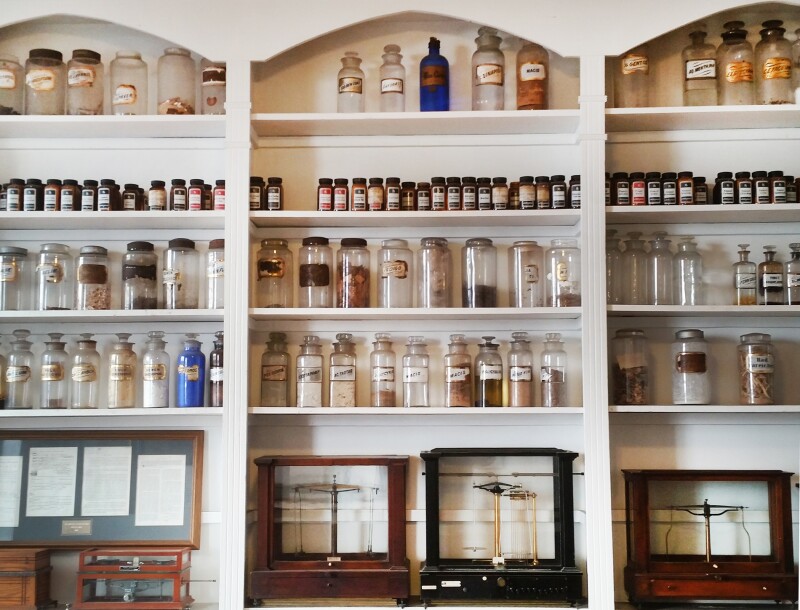Long famous for its nonstop festivals, spontaneous street-dancing, and gustatory binges, New Orleans is also known for—and rightfully proud of—the city’s rich and nuanced 300-year history. The best way to delve into its past—and learn about its extraordinary culture—is to visit one of New Orleans’s more unusual museums. Thankfully, stumbling upon a great one is as easy as stumbling down Bourbon Street slurping a booze slushy—and it delivers a far deeper sense of satisfaction and connection (while providing context for all that revelry). The Crescent City boasts some 45 museums, from a birdhouse-sized box in an Irish Channel neighborhood front yard to the behemoth 250,000-square-foot Mardi Gras World. The only question is where to start: Try one of these six small-scale favorites, which you’d be hard-pressed to find elsewhere.
Backstreet Cultural Museum
The Backstreet Cultural Museum occupies a small house (a former funeral home, in fact) that comes packed with character. The ineffable spirit of the historic Treme neighborhood permeates this museum, which displays curator Sylvester Francis’s permanent collection of dazzling Mardi Gras Indians costumes, second-line parade outfits, jazz funeral photos, and music memorabilia. It’s also a good place to learn about upcoming New Orleans parades and not-to-be-missed festivals, which extend far beyond Mardi Gras to run in one form or another on nearly every weekend of the year. A venerated institution and community touchstone, the Backstreet is the real deal—an expression of the deep devotion New Orleanians have to preserving their arts and traditions.

Voodoo beliefs and practices are entwined with the city’s identity.
Photo by Demetrius Gonzales
Historic Voodoo Museum
After voodoo (or vodou) came to New Orleans in the 1700s—first via West African slaves, then with Haitians after the Haitian Revolution—it entwined with the city’s identity. Which is why, since the 1970s, a French Quarter visit has been deemed incomplete without a stop at the tiny Historic Voodoo Museum. If it’s lore you seek, you’ll find it here. If it’s love or money, you can leave offerings for the gods, scrawl your deepest desire on a slip of paper, or snag your own gift-shop voodoo doll to ostensibly do the trick. Photos are encouraged (yes, that’s a human skull you just Instagrammed!). To experience more authentic voodoo in quieter environs, visit priestess Sallie Ann Glassman’s shrines in her botanica, Island of Salvation, in the Marigny district’s New Orleans Healing Center, or stroll down Rosalie Alley, in the Bywater neighborhood, with its transporting voodoo imagery.
Treme’s Petit Jazz Museum
Treme’s Petit Jazz Museum is located in the very neighborhood that birthed jazz and is a must-visit for any aficionado. Since curator Al Jackson opened the institution in Treme in 2017, visitors have marveled at his musical treasure trove, which includes original recording contracts for Ray Charles, Little Richard, and Fats Domino; a 1954 performing contract signed by Louis Armstrong; a djembe drum from Senegal; and much more. You could tour the one-room museum in 20 minutes, but don’t: Leave time to chat with Jackson, a gifted raconteur who can teach you about the evolution of New Orleans’s musical soul.

Learn about the journey, heritage, and achievements of the free people of color in New Orleans at Le Musée de F.P.C.
Courtesy of Le Musée de F.P.C.
Le Musée de F.P.C.
Before the Civil War, New Orleans was home to the largest and wealthiest population of free people of color (abbreviated to F.P.C. by the museum) in the South. To understand their journey, heritage, and achievements, schedule an hour-long tour of Treme’s Le Musée de F.P.C.—the only museum of its kind in the United States. The detailed lesson, both profoundly sobering and inspirational, begins with the founding of New Orleans in 1718 and continues to the 1896 Plessy v. Ferguson Supreme Court decision, a case that started in New Orleans and that resulted in national segregation. This vital, if lesser-known, cultural center tells important truths about the history of free and enslaved African Americans, while sharing priceless original documents, period furnishings, and more than 250 pieces of thematic artwork.

New Orleans was home to America’s first licensed pharmacist in the 1800s.
Photo by Stephanie Mackin
New Orleans Pharmacy Museum
Located in a French Quarter building where the nation’s first licensed pharmacist, Louis J. Dufilho, Jr., lived and practiced in the 1800s, the New Orleans Pharmacy Museum is a time-travel extravaganza. You can visit independently, but the insightful (and included with admission) 1 p.m. tour on weekdays is worthwhile to hear about medicine’s fascinating, unsterilized history and to eyeball some seriously iffy relics, like lead syringes, bottles once filled with opium-based teething formulas, strychnine-laced cosmetics, and over-the-counter heroin; plus, here’s your chance to view a pig’s-rib toothbrush and a calcified goat’s hairball. Don’t miss a wander upstairs, too, to learn about New Orleans’s time-honored apothecary-cocktails connection.
House of Dance & Feathers
For a deep dive into the genuine spirit of Mardi Gras and New Orleans culture, call up Ronald Lewis, proprietor of House of Dance & Feathers, and ask if he’s open. If this former Mardi Gras Krewe du Vieux king says “Come on by,” drop your day-drink and hightail it to the Lower Ninth Ward. Lewis’s donation-based mini-museum—a shed in his yard, really—is a mesmerizing repository of curios and collectibles related to New Orleans’s complex social web of Social Aid & Pleasure Clubs, Mardi Gras Indians, Skull & Bones Gangs, Baby Dolls, and more. There’s plenty to peruse—ornate beadwork and feathered masks, Zulu coconuts and Muses shoes (two of the most coveted Mardi Gras throws), vintage photos galore—but the true museum is Lewis himself. A living history book and one of the city’s coolest (and kindest) personalities, he delights in sharing his time and wisdom.











